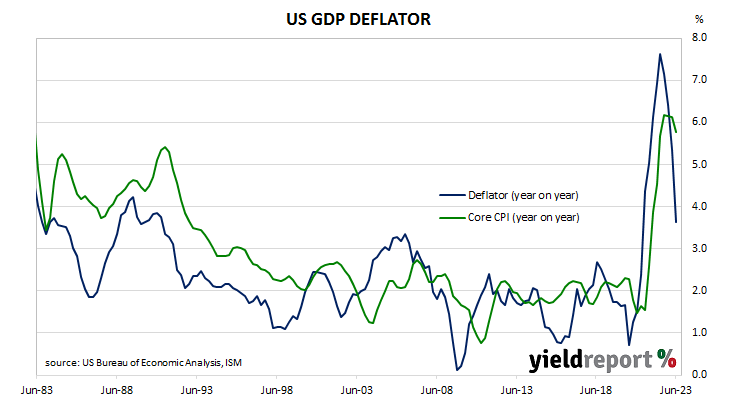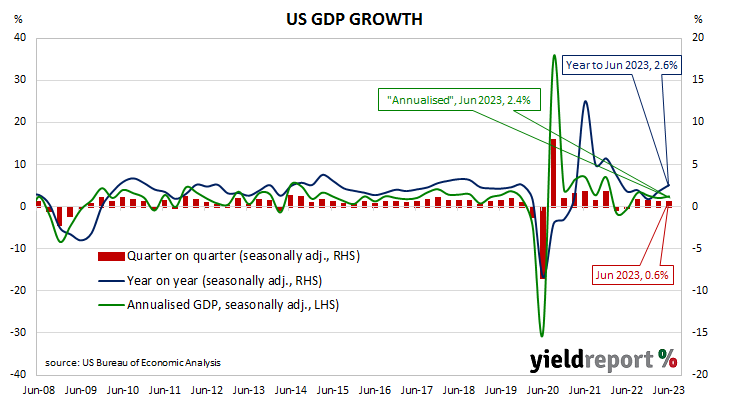Summary: US GDP up 0.6% (2.4% annualised) in June quarter, above expectations; NAB: report details impressive; ANZ: slowing in real personal consumption growth will be welcomed by FOMC; GDP price deflator rate slows from 5.3% to 3.6%.
US GDP growth slowed in the second quarter of 2019 before stabilising at about 0.5% per quarter. At the same time, US bond yields suggested future growth rates would be below trend. The US Fed agreed and it reduced its federal funds range three times in the second half of 2019. Pandemic restrictions in the June quarter of 2020 sent parts of the US economy into hibernation; the lifting of those same restrictions sparked a rapid recovery which lasted until 2022.
The US Bureau of Economic Analysis has now released the June quarter’s “advance” GDP estimates and they indicate the US economy expanded by 0.6% or at an annualised rate of 2.4%. The result was more than the 0.4% increase (1.8% annualised) which had been generally expected as well as the March quarter’s 0.5% rise after revisions.
“Details in the report were also impressive with consumer spending up a solid 1.6%, considering the outsized 4.2% gain in Q1,” said NAB senior FX strategist Rodrigo Catril. “Business investment was strong and stronger-than-expected durable goods orders bode well for future investment.”
US GDP numbers are published in a manner which is different to most other countries; quarterly figures are compounded to give an annualised figure. In countries such as Australia and the UK, an annual figure is calculated by taking the latest number and comparing it with the figure from the same period in the previous year. The diagram above shows US GDP once it has been expressed in the normal manner, as well as the annualised figure.
US Treasury bond yields rose significantly on the day. By the close of business, the 2-year Treasury bond yield had added 8bps to 4.93%, the 10-year yield had gained 14bps to 4.00% while the 30-year yield finished 10bps higher at 4.04%.
In terms of US Fed policy, expectations of a lower federal funds rate in the first half of 2024 softened. At the close of business, contracts implied the effective federal funds rate would average 5.325% in August, in line with the current spot rate, and then increase to an average of 5.345% in September. December futures contracts implied a 5.405% average effective federal funds rate while July 2024 contracts implied 4.945%, 38bps less than the current rate.
“For the FOMC, the slowing in real personal consumption growth will be welcome,” said ANZ economist Jack Chambers. “It was around potential in Q2 and implies that monetary policy is probably having the desired restraint on real household demand.”
One part of the report which is often overlooked are the figures regarding the GDP price deflator, which is another measure of inflation. The GDP price deflator is restricted to new, domestically-produced goods and services and it is not based on a fixed basket as is the case for the consumer price index (CPI). The annual rate slowed from the March quarter’s figure of 5.3% to 3.6%.



